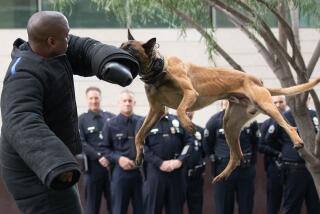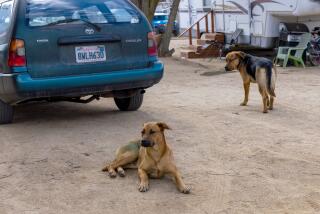Tribute to soldier’s best friend
The small group of veterans gathers at Riverside’s March Field Air Museum once a year, traveling from all corners of the country to mourn forgotten heroes of battle.
They come to honor the dogs that saved lives by detecting booby traps and watching over military camps, dogs that became trusted friends in times of loneliness.
The meeting point is the 16-foot-tall West Coast War Dog Memorial, which holds a bronze statue of a soldier and his German shepherd.
For years, veterans have sought to have the contributions of war dogs recognized with a national monument.
The West Coast memorial, designed by Denver-area sculptor A. Thomas Schomberg, was to have been placed at Riverside National Cemetery, but a national Veterans Affairs advisory committee argued that doing so would be disrespectful. The museum agreed to take it, and the veterans to meet there every year on the Sunday before Memorial Day.
“It honors another aspect of the military that is forgotten,” said Patricia Korzec, the museum’s executive director. “Man’s best friend truly turned out to be man’s best friend on the battlefield.”
Legislation currently weaving through Congress would establish a national memorial at Ft. Belvoir, Va. It is included in the House’s 2008 defense authorization bill and is waiting to be heard in the Senate. If passed, it could be signed into law as early as November.
The tribute could not come soon enough for many war dog handlers, most of whom were forced to leave their dogs behind when they returned to the United States after World War II, the Korean War and the Vietnam War.
John Burnam, a Vietnam veteran who spent countless days with his German shepherd, Clipper, credits the dog with saving his life several times.
Once while on combat patrol, Clipper stopped, his muscles tensed and ears perked toward the sky. Burnam, who always followed the dog’s lead, ducked to the ground. Machine gun fire erupted, killing a soldier in front of them.
Burnam said he and Clipper played dead for 10 minutes before help arrived.
If not for Clipper, Burnham said, he has no doubt that he would have died. “We were basically leading combat patrols, and the dogs, with their natural abilities, were leading us.”
Burnam now travels the country, advocating for a national war dog monument. He and others proposed generating the $3 million needed for the monument through fundraisers.
“We aren’t equating them to humans, but we are saying . . . there are families that have grandkids as a result of these dogs being deployed,” said Burnam, author of “Dog Tags of Courage: Combat Infantrymen and War Dog Heroes in Vietnam.”
The Vietnam Dog Handler Assn. estimates that dogs saved 10,000 soldiers’ lives during the Vietnam War. They would alert handlers to tripwires blowing in the breeze or the otherwise undetectable scent of buried explosives.
Depending on their level of aggressiveness, the dogs were sent to two camps to hone their skills before deployment. Scout dogs were trained at Ft. Benning, Ga., and sentry dogs at Lackland Air Force Base, Texas, still one of the country’s largest dog training facilities.
The scout dogs learned to alert handlers to foreign scents and sniff out land mines, snipers, enemy sentries and patrol camps.
Sentry dogs learned to stand guard and protect bases, airfields, ammunition dumps and fuel dumps.
The dogs are said to have lessened the chance of an ambush while on combat patrol and lifted soldier morale.
The federal government, fearing that such dogs could not be rehabilitated after the war, classified them as equipment.
They were euthanized at the end of battle, much to the dismay of their handlers.
Of the estimated 4,000 dogs used in the Vietnam War, only about 200 returned to the United States.
In 2000, legislation that allowed handlers to adopt war dogs and bring them home was signed by President Clinton.
Today, canine corps are deployed in Afghanistan and Iraq and are used to secure bases and guard prisoners. Some of those dogs wear backpacks equipped with radios and are given radio commands from soldiers in protected areas.
“These dogs have been serving our country and on the battlefield in every war,” Burnam said. “They’ve been doing it and saving American lives with valor.”
The military first started using canine scouts and messengers in World War I.
After meeting a war dog handler at a Memorial Day event, Rep. Walter B. Jones (R-N.C.), agreed to sponsor a bill for the national monument.
“It’s a love that is hard to define,” he said. “These comrades crawled in the jungle at nighttime to find where the enemy was and sniffed out enemies. They need to be recognized as an intricate part of our national security.”
The memorial in Riverside was dedicated in 2000 before more than 100 Vietnam veterans. At the base of the monument, paw prints and emotional messages relay the bond between the veterans and the dogs.
“My friend, Bingo. Leaving you was sad and wrong.”
“To my rebel protector and friend.”
“If not for Dusty, I wouldn’t be home.”
On a recent sweltering morning, Mike McKelroy, who served as a dog handler in Vietnam for 18 months, visited the memorial with Ken, his 7-year-old German shepherd.
The dog has the same name as the one who served alongside McKelroy in Vietnam -- the one that saved his life on a dusky morning when trees blocked a hidden enemy camp from his sight but not from his dog’s nose.
“This is so lifelike,” he said, gazing at the sculpture. “You live, breathe and sleep with your dog, and he becomes a part of you.”
jonathan.abrams@ latimes.com
More to Read
Sign up for Essential California
The most important California stories and recommendations in your inbox every morning.
You may occasionally receive promotional content from the Los Angeles Times.










